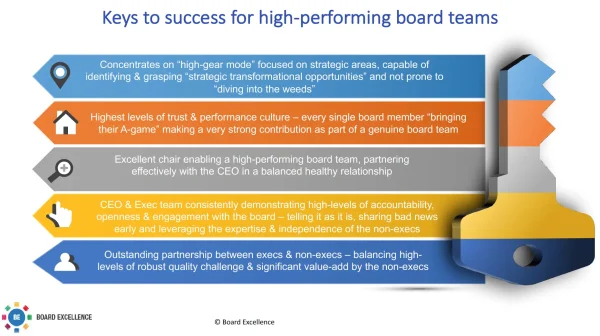While watching the outstanding recent win by the Irish rugby team against the New Zealand All-Blacks, I was reminded of a strongly held view I have of the strong parallels between the best board teams and high-performing sports teams. For all the supporters at the match and the armchair supporters across Ireland and internationally looking on, there was a deep sense of pride in the incredible level of performance, the commitment by each player to bring their A-game, the breath-taking work ethic, the incredible leadership off-the-pitch by the coach Joe Schmidt, the leadership on the pitch by the captain Rory Best and senior players like Johnny Sexton. I have often written that a true test of any board team is that they would be comfortable to stream the next board meeting live to all their shareholders and stakeholders. In that scenario, shareholders looking on at their board team deserve to have that same feeling as I and the Irish rugby fans felt seeing a team at the very top of their game, balancing outstanding levels of challenge and debate, adding significant value strategically, every board member bringing their A-game, working very hard to add genuine value, led by an outstanding chair and the collective board team excelling on behalf of their shareholders and stakeholders.
Outlined in Figure 1 below is a summary from our board best practices workshop of the key characteristics of high-performing board teams. Over the years as we have supported board teams across different countries and different sectors, these characteristics are remarkably consistent. These are now considered in detail below.

Outstanding partnership between execs & non-execs – balancing high levels of robust quality challenge & significant value-add by the non-execs
This is at core of great board teams where the exec and non-exec board members build a great partnership over time which enables a very high level of quality debate and challenge whereby the board members have built the levels of respect and trust that allows the board team to “really get at it” and push each other to make the very best decisions. As a quid pro quo to the CEO and executive team facilitating the non-execs to discharge their critical oversight responsibilities, the non-exec board members need to add genuine value, particularly in the strategy area but also in times of crisis whereby the CEO and executive team need the non-execs to roll up the sleeves and help with fresh independent thinking to tackle tough challenges facing the organisation.
CEO & Exec team consistently demonstrating high-levels of accountability, openness & engagement with the board – telling it as it is, sharing bad news early and leveraging the expertise & independence of the non-execs
I often say to board teams and particularly the CEO and executive team, is that where you have a CEO and executive team who genuinely respect and understand the role of the board and who consistently demonstrate the highest levels of accountability and integrity, this is an incredible foundation to build everything else in the board around. Where the CEO and executive team are very open with the board on the performance of the organisation, the serious issues and the problems keeping the CEO up at night, this enables the non-executive board members to very effectively understand the current state of the organisation’s performance, the serious issues and to discharge their critical oversight responsibility on behalf of the shareholders to protect the financial and operational health of the organisation. It makes such a difference to a board team when a CEO and executive team shares genuine bad news early and give the board time to collectively brainstorm and either identify solutions or mitigating strategies to help address the serious issues.
Excellent chair enabling a high-performing board team, partnering effectively with the CEO in a balanced healthy relationship
I was asked recently at a talk I was giving on board dynamics on what was the single biggest factor which impacted a board’s effectiveness and performance. Without hesitation, I outlined that the quality of the board chair’s leadership of the board team is the biggest single factor which impacts on a board’s effectiveness and performance. The board chair sets the tone for the board team, sets the level of performance culture and conducts the board team orchestra in terms of enabling a very cohesive team to out-perform for their shareholders and stakeholders. A key component of this role is the development of a very healthy partnership with the CEO that balances very tough challenge and oversight with incredible levels of support to the CEO to help he/she excel in driving the organisation forward hour to hour.
Highest levels of trust & performance culture – every single board member “bringing their A-game” making a very strong contribution as part of a genuine board team
When you look at an outstanding sports team at the very top of their game, you get a great sense of the very high levels of trust and respect the players have for each other. They hold both themselves and their team members to the highest standards. Every player demonstrates an incredible work ethic and commitment to the team and understands that they need to consistently bring their A-game. The very best board teams behave in exactly the same way. Every single board member carries their weight, is genuinely contributing and can hold their head up high in front of their board colleagues that they make a key contribution both at the board meetings and in between board meetings. So many board teams tolerate board members who make little to no contribution, who are content to show up, ask the odd obvious question but in the cold light of day add little to no value to the board team and are doing a disservice to shareholders and stakeholders who deserve a lot better than this.
Concentrates on “high-gear mode” focused on strategic areas, capable of identifying & grasping “strategic transformational opportunities” and not prone to “diving into the weeds”
One area where the best board teams really differentiate themselves from average boards is the whole area of strategy and ensuring that the board is highly focused on strategic areas and identifying strategic opportunities to “move the needle for the organisation”. So many board teams get into “groundhog-day mode” where they continually spend far too much time at board meetings scuba-diving into the depths of the financial numbers and operational minutiae and thereby have little time to really look up and out as a board team to figure out strategically how the organisation is going to adapt and thrive in the face of considerable disruption and risks arising at un-relenting pace in all sectors. To enable this “strategic high-gear mode”, the best board teams develop a very effective capability to understand the operational and financial performance of the organisation enabled by a high-quality board information model and a highly open executive team.
Summary
Many boards find it strange the concept of the board as a team in its own right. Yet, if you think about it, the board is very much a team, slightly unusual in terms of a mix of executives driving the organisation forward hour-to-hour and non-executive directors who are independent and with a very onerous set of complex responsibilities. As a board team, each and every board member, led by the board chair, has a fundamental responsibility to embrace the responsibility entrusted in them by the shareholders and stakeholders to go that extra mile, demonstrate the highest levels of accountability, ethics, integrity, respect and work-ethic, set the bar very high in terms of performance culture making an outstanding contribution and being an integral part of an outstanding board team excelling on behalf of their shareholders and stakeholders.
Kieran Moynihan is the managing partner of Board Excellence ( https://boardexcellence.com) – supporting boards & directors in Ireland, UK and internationally excel in effectiveness, performance and corporate governance.
Think your business could benefit from our services and expertise? Get in touch today to see how we can support your board excel for its shareholders, employees and stakeholders.
.

